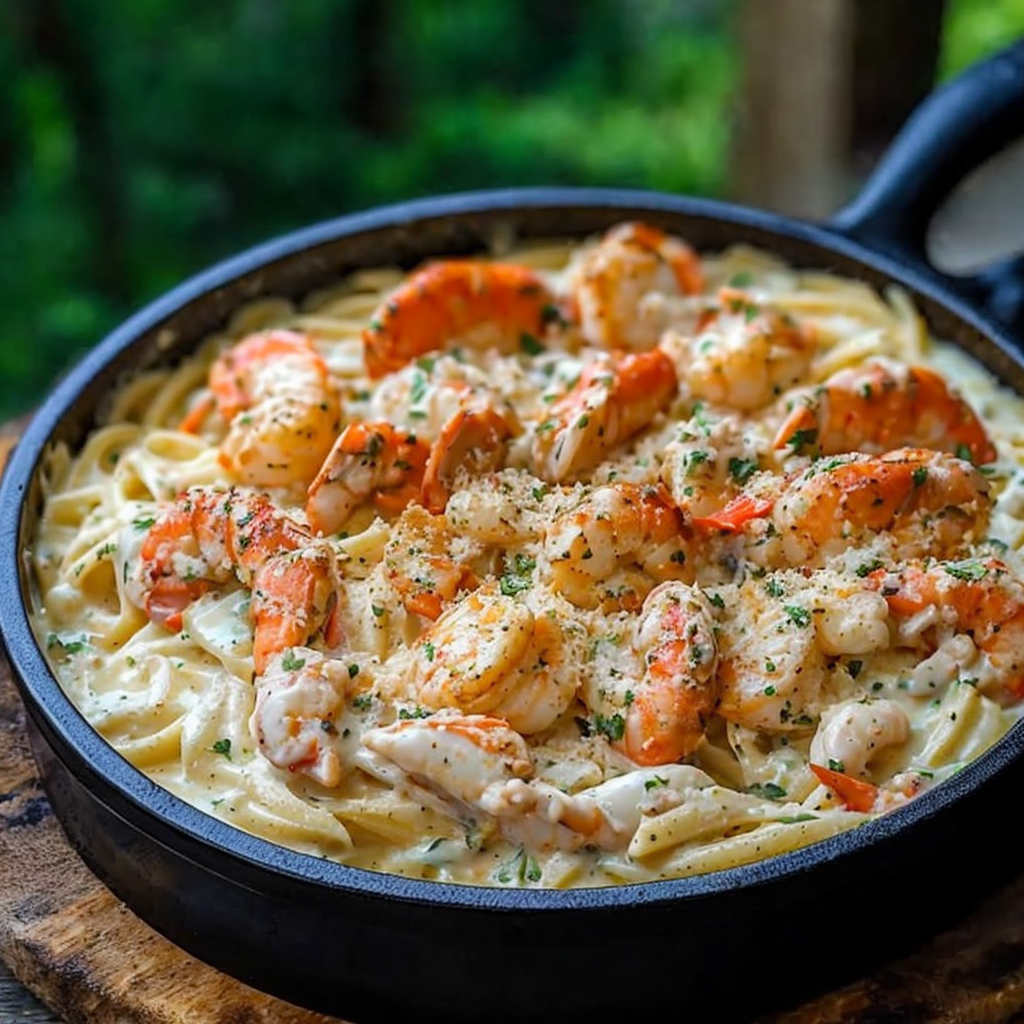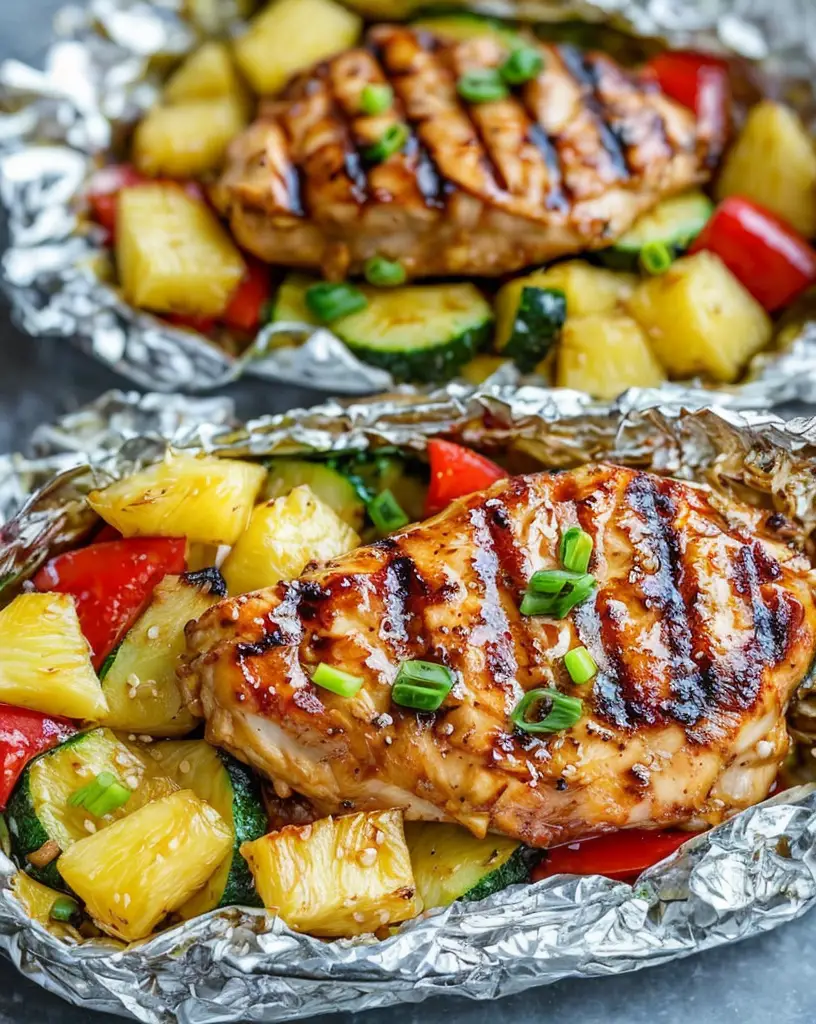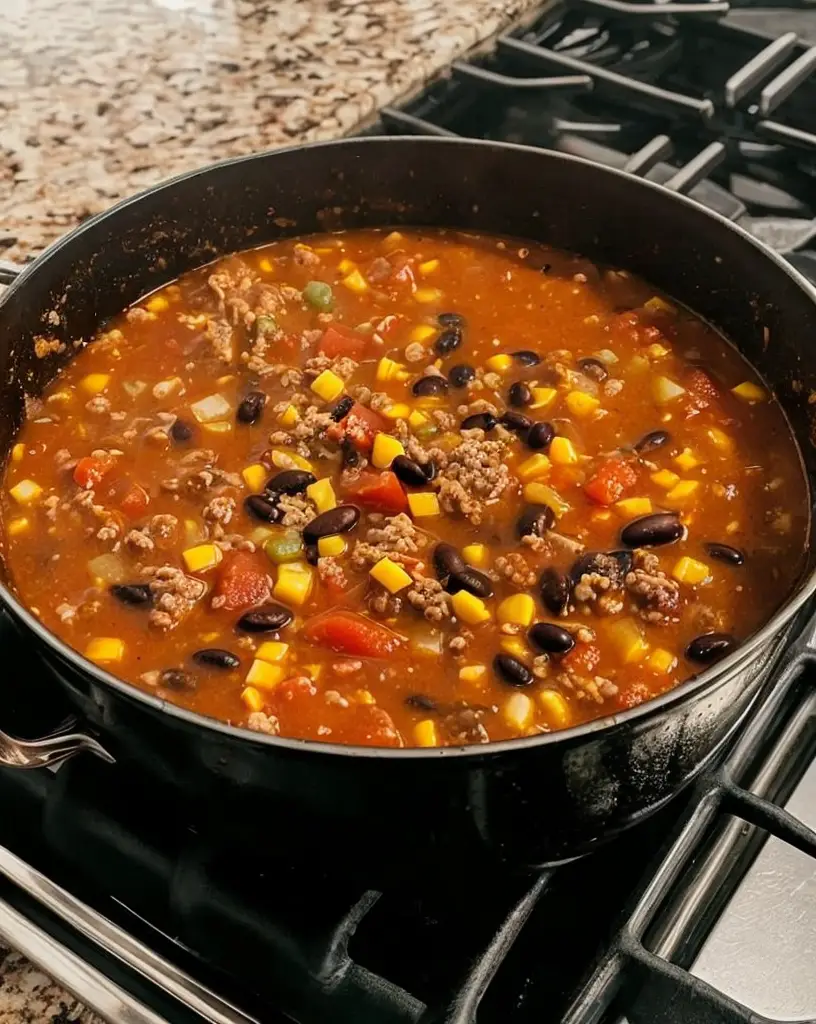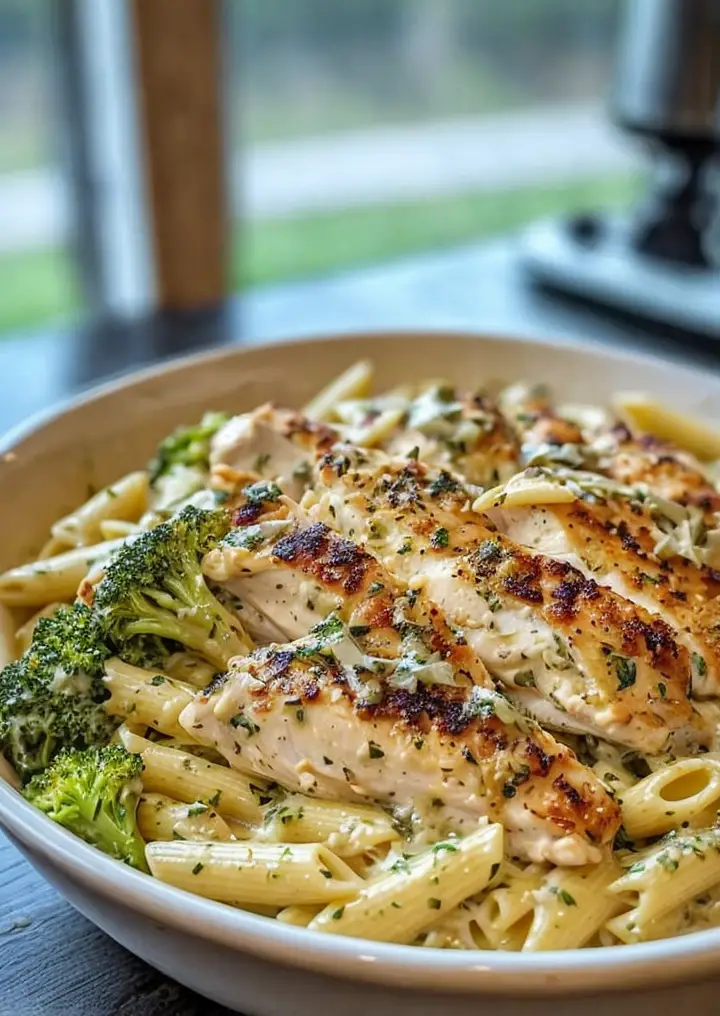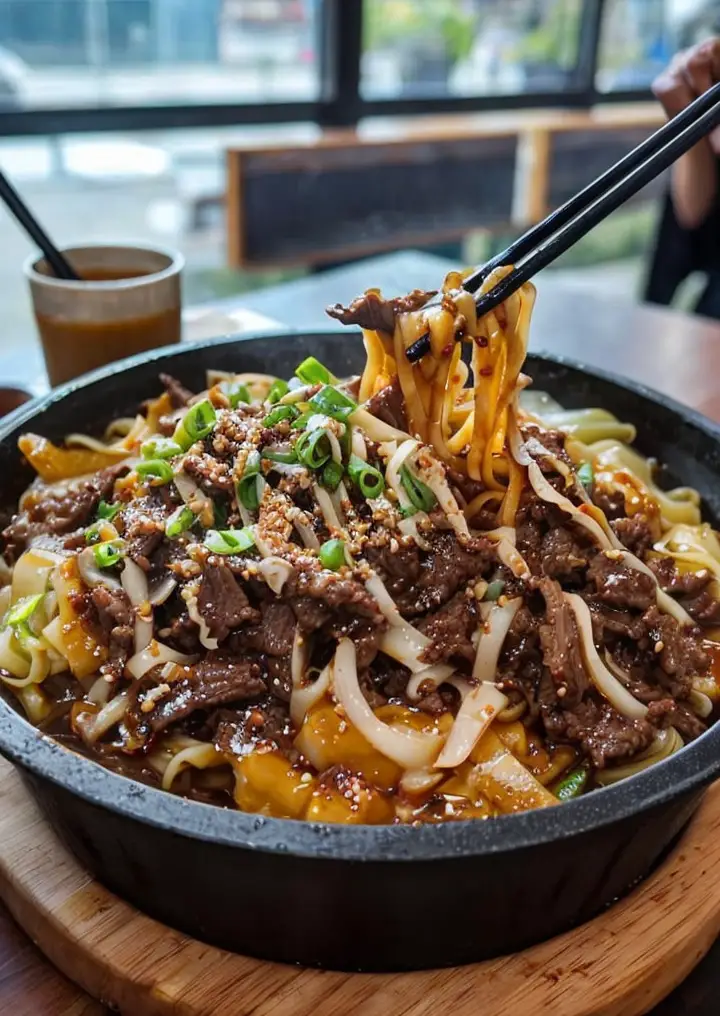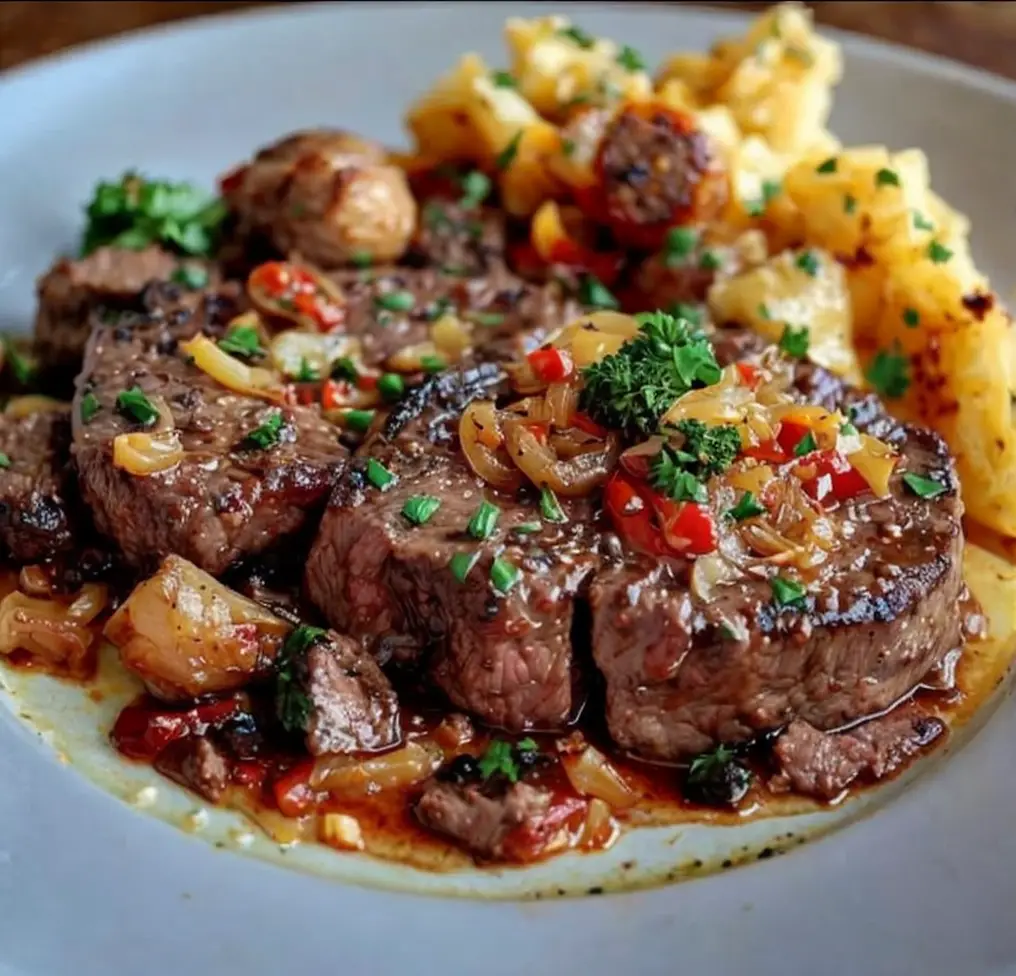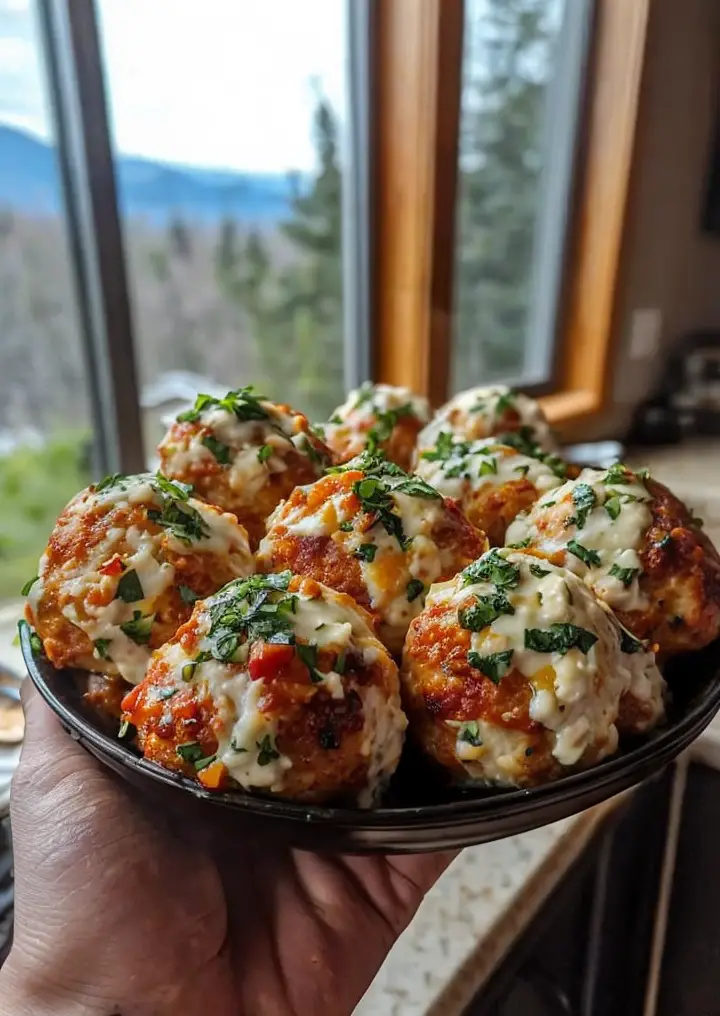Spicy Seafood Alfredo Medley: A Decadent Taste of the Ocean
Indulge in the rich and creamy goodness of Spicy Seafood Alfredo Medley, a delightful dish that brings the flavors of the ocean right to your dining table. This pasta dish combines succulent shrimp, tender scallops, and a hint of spice, all enveloped in a velvety Alfredo sauce. The fusion of heat and creaminess creates an irresistible flavor profile that will leave you craving more. Perfect for a cozy dinner or special occasions, this dish elevates your culinary experience and warms your soul.
As you take your first bite of this Spicy Seafood Alfredo Medley, the luscious creaminess coats your taste buds, while the seafood bursts with fresh, ocean-like flavors. The heat from pepper flakes and a splash of lemon juice create a delicious contrast that elevates the traditional Alfredo into a bold and exciting dish. Each component of this recipe complements one another, enticing both seafood lovers and pasta enthusiasts alike.
Quick Recipe Highlights
- Flavor Profile: The combination of rich Alfredo sauce and spicy seafood creates a balanced taste that’s both creamy and zesty.
- Texture: The freshness of seafood combined with the silky pasta creates a mouthwatering combination that satisfies every bite.
- Aroma: The enticing scents of garlic, seafood, and aromatic spices fill your kitchen, inviting everyone to the table.
- Visual Appeal: The vibrant colors of the shrimp and scallops against a backdrop of creamy pasta make for a beautiful presentation.
- Skill Level Needed: An intermediate cooking skill level allows for mastering the sauce and cooking seafood to perfection.
- Special Equipment: Standard kitchen tools, including pots, pans, and a colander, are sufficient for making this delightful dish.
Recipe Overview
- Difficulty Level: This Spicy Seafood Alfredo Medley involves fundamental cooking techniques, such as sautéing and simmering, making it accessible yet intriguing.
- Category: An ideal choice for a main course, it fits family dinners or a romantic date night, showcasing culinary finesse.
- Cuisine: Rooted in Italian cuisine, this dish embraces seafood while adapting the traditional Alfredo to a spicier profile.
- Cost: Ingredients like shrimp and scallops can be moderate in price, allowing you to create a gourmet experience without breaking the bank.
- Season: This dish shines in warm weather when fresh seafood is readily available, but it also impresses year-round.
- Occasion: Perfect for special gatherings, date nights, or a weekend treat, it draws attention and admiration from guests.
Why You’ll Love This Recipe
The Spicy Seafood Alfredo Medley is not only scrumptious but offers a delightful taste and texture appeal that stands out. The creamy sauce envelops the pasta, while the succulent seafood adds an ocean-fresh quality, creating an unforgettable dining experience. The hint of spice elevates the dish, ensuring that each mouthful is a thrilling adventure for your palate.
The convenience of preparing this dish makes it a favorite for busy home cooks. The preparation does not require advanced techniques, and most of the ingredients can be sourced from your local grocery store. The 45 minutes from start to finish means you can whip up a restaurant-quality meal in no time, allowing you to focus on what really matters—enjoying it with family and friends.
In addition to its fantastic flavors, this recipe packs a nutritional punch. Seafood is known for its high protein content and rich omega-3 fatty acids, which can benefit heart health. Combined with the nutrition from garlic, herbs, and pasta, this dish offers a well-rounded meal that not only tastes good but is good for you.
Social gatherings come alive with the Spicy Seafood Alfredo Medley on the table. This dish naturally encourages sharing and conversation as it captivates your guests with its alluring aroma and beautiful presentation. It’s an excellent choice for entertaining, making your evening memorable.
Finally, the cost-effectiveness of this recipe cannot be overlooked. While seafood may seem indulgent, sourcing fresh ingredients and preparing them at home is significantly cheaper than dining out. This means you can enjoy luxurious flavors without the hefty price tag, making it a worthy addition to your recipe repertoire.
Historical Background and Cultural Significance
The origin of seafood pasta dishes can be traced back centuries, with the blending of local ingredients showcasing regional specialties. Italian cuisine, renowned for its pasta, began incorporating seafood into its vast array of dishes, particularly in coastal regions. The Mediterranean influence is evident in the use of fresh ingredients that highlight the natural flavors of seafood alongside creamy sauces.
The cultural importance of the Spicy Seafood Alfredo Medley lies in its ability to gather people around the table. Multi-course meals in Italy traditionally encourage communal dining, where each dish tells a story. This recipe reflects the versatility and creativity of Italian cooking, fusing comfort with sophistication.
Over the years, this dish has evolved to incorporate modern tastes, allowing for various adaptations. Chefs and home cooks alike experiment with heat levels, combining spices and varying the seafood used to reflect personal preferences and seasonal ingredients. This evolution showcases how traditional recipes can change while retaining their original charm and appeal.
Regional variations also exist, with many areas adding their local twist to the classic alfredo sauce. While some may prefer adding saffron or local herbs, others might choose to include distinct seafood choices based on what’s fresh and available. These differences highlight the diversity of Italian seafood cuisine, making every version of Spicy Seafood Alfredo Medley a unique experience.
Ingredient Deep Dive
Shrimp: Shrimp has been a staple of coastal cuisine for centuries, celebrated for its delicate flavor and versatile nature. Rich in protein and low in calories, shrimp also provide essential nutrients like selenium, which can boost immune health. When selecting shrimp, it’s best to look for those that are firm and smell like the sea, as freshness is key to a flavorful dish. For storage, keep shrimp refrigerated and use within a day or two, and freeze if you need to keep them longer. If fresh shrimp isn’t available, frozen shrimp work well too.
Scallops: Scallops are known for their sweet, delicate flavor and tender texture, making them a favorite in gourmet dishes around the world. They are an excellent source of vitamin B12, magnesium, and omega-3 fatty acids, promoting heart health and overall well-being. To choose the best scallops, look for a moist appearance and a clean, ocean-like smell. They can be stored in the refrigerator for a day or two, while freezing is an option for longer retention. If scallops are unavailable, you can substitute them with other shellfish, but the flavor profile will differ.
Fettuccine: Fettuccine, a flat and thick pasta variation, hails from Italy and is perfect for saucy dishes like Alfredo. Its broader surface area allows it to hold onto rich sauces effectively. Made primarily from wheat flour and eggs, it’s a source of carbohydrates and protein. When choosing fettuccine, either fresh or dried versions work well, although fresh generally cooks faster. To store, keep it in a cool, dry place, and avoid moisture to prevent clumping. You can substitute it with other pasta shapes like tagliatelle or pappardelle if needed.
Heavy Cream: Heavy cream is the base of any Alfredo sauce, lending its rich, velvety texture to the dish. This dairy product is incredibly versatile and rich in fat, which makes it great for achieving that creamy consistency. Selecting high-quality heavy cream can elevate your sauce’s taste significantly. Store it in the refrigerator, and be sure to use it by the expiration date. If a lighter option is desired, half-and-half can substitute heavy cream, although the texture will be less rich.
Common Mistakes to Avoid
- Overcooking seafood: This can lead to rubbery shrimp and dry scallops. Cook them just until they turn opaque and are tender to the bite.
- Making runny Alfredo sauce: Not allowing the sauce to simmer appropriately can result in a watery texture. Ensure you let it reduce slightly for the right consistency.
- Using low-quality ingredients: Quality seafood and fresh ingredients make a significant difference in flavor. Opt for the best you can find.
- Skipping the seasoning: Under-seasoned dishes can taste bland. Don’t forget to adjust the seasoning with salt, pepper, and spices to enhance all flavors.
- Not combining pasta and sauce properly: Adding pasta to the sauce instead of the other way around can lead to clumping. Mix them together gently for a cohesive dish.
- Inadequate prep: Rushing through the preparation leads to mistakes. Take your time to measure and prep ingredients before cooking.
- Ignoring pasta cooking time: Undercooking or overcooking pasta can ruin the dish. Follow package instructions and taste as the time approaches.
- Wrong serving temperature: Alfredo dishes are best served hot. Allow them to cool slightly before serving, and never serve them cold.
- Neglecting garnishes: A sprinkle of parsley or a drizzle of olive oil can elevate your dish visually and flavor-wise. Don’t skip the presentation!
- Forgetting to stir: When making the sauce, be sure to stir consistently to prevent it from sticking to the bottom and burning.
Essential Techniques
Making Alfredo Sauce: This cream-based sauce requires a delicate balance of heat and stirring. It’s essential to keep the cream at a simmer, not a boil, to prevent curdling. To master it, start with low heat, add grated Parmesan gradually, and keep whisking until melted and combined. Look for a smooth, velvety texture as the visual cue for success.
Cooking Seafood: Properly cooking seafood can be tricky. Sauté quickly over high heat ensures that the seafood cooks evenly and avoids losing moisture. To master this, add seafood to a hot pan and allow it to sear; don’t overcrowd the pan. Look for a golden crust and opaque flesh as signs of doneness.
Pro Tips for Perfect Spicy Seafood Alfredo Medley
1. Soak pasta water: Keep some pasta water to add to the sauce. A splash can help thin it out and enhance the flavor.
2. Use freshly grated cheese: For an authentic Alfredo sauce, opt for freshly grated Parmesan. Pre-shredded ones may contain anti-caking agents that hinder melting.
3. Consider a splash of white wine: Adding white wine to the sauce can bring acidity and a depth of flavor to the dish.
4. Balance spices: Adjust the level of spiciness according to your taste preference. Start with a pinch of red pepper flakes, then adjust as needed.
5. Blend herbs: Fresh herbs such as parsley or basil can brighten the dish. Toss them in right before serving for maximum flavor.
6. Let the sauce rest: Allow the Alfredo sauce to sit for a few minutes off heat before serving, as it thickens up nicely and the flavors meld better.
7. Vary your seafood: Feel free to mix up the types of seafood based on what’s available or in season—squid, crab, or lobster would all be delicious alternatives.
8. Don’t reheat leftovers in the microwave: To avoid curdling your sauce, reheat gently in a pan on low heat.
Variations and Adaptations
Regional variations often reflect local seafood availability; for instance, in New England, adding lobster to the dish can add a luxurious touch that complements the creamy base well. Seasonal adaptations can include springtime vegetables like asparagus or peas to introduce freshness and color.
For dietary modifications, consider using gluten-free pasta to accommodate gluten-sensitive individuals, ensuring everyone can enjoy this delightful dish. Vegetarians can substitute seafood for mushrooms or artichoke hearts, thus maintaining the dish’s essence while catering to their preferences.
If you’re seeking flavor variations, consider adding sun-dried tomatoes for a tangy kick or fresh spinach for a pop of color and nutrition. These additions not only enhance the dish’s appeal but also augment the health benefits.
Texture modifications can be achieved by adding a crunchy topping like toasted breadcrumbs or offering a side of garlic bread as a complementary crunch to the dish’s creaminess.
Finally, presentation alternatives can include serving the dish in a hollowed-out bread bowl, offering a fun and visually striking way to delight your guests.
Serving and Presentation Guide
For plating, twirl the fettuccine neatly on each plate, creating height for visual appeal. Use a large spoon to create a nest with the pasta, and place the seafood artfully on top. Garnishing with fresh herbs adds a vibrant touch that enhances the dish’s overall presentation.
Consider garnishing with lemon wedges or additional Parmesan shavings to emphasize flavors and provide a fresh aroma. Modern serving suggestions include using bowls for a casual feel or plates for more formal dining settings. Pay attention to portion control; larger portions can be served for dinners while smaller portions are preferable for appetizers or buffets.
Temperature considerations are crucial, as this dish is best served immediately after cooking. If it does cool down, consider tossing it over medium heat to ensure it’s served hot and delicious.
Wine and Beverage Pairing
For an excellent wine pairing, a crisp, chilled Sauvignon Blanc enhances the seafood’s flavor while complementing the creamy sauce. Alternatively, a light Pinot Grigio offers a refreshing contrast and balances the richness of the dish.
For non-alcoholic options, consider sparkling water with a twist of lemon or a zesty ginger ale to cleanse the palate between bites. If your gathering is more casual, a light iced tea with a hint of citrus can pair surprisingly well, providing a refreshing balance.
Tea enthusiasts might enjoy a mild herbal tea, like chamomile or peppermint, after the meal for a soothing conclusion. Remember to serve all beverages chilled or at the appropriate temperature for optimal enjoyment.
Storage and Shelf Life
To store leftovers, place them in an airtight container in the refrigerator. Properly stored, they can last up to three days without losing too much quality. For freezing, portion the dish into freezer-safe containers and use within two months for the best flavor and texture.
When checking for spoilage, look for off-smells, significant changes in texture, or mold. To reheat, gently warm it in a saucepan over low heat, adding a splash of cream or reserved pasta water to restore its creamy texture, avoiding the microwave’s direct heat that can alter the sauce.
Make Ahead Strategies
Prepare the sauce a day in advance and refrigerate it. Reheating gently allows flavors to develop further. You can also pre-cook the seafood lightly and store it separately, ensuring it doesn’t overcook during the final assembly.
Quality impact can be optimized by pre-prepping ingredients such as chopped garlic or herbs, slicing seafood, and measuring pasta ahead of time. When the time comes to assemble, your effort pays off with a quick and efficient cooking process.
Incorporate fresh elements just before serving, like tossing in fresh herbs or a drizzle of olive oil, as these ingredients deliver maximum flavor without losing freshness during storage.
Scaling Instructions
When halving the recipe, simply divide all components by two while ensuring you maintain the balance of flavors. If doubling or tripling, it’s important to monitor the cooking times, as larger batches may need a few extra minutes to cook thoroughly.
For equipment adjustments, consider using larger pots and pans to accommodate extra servings. Timing modifications should account for temperature variances, so taste regularly and adjust accordingly.
Storage considerations are crucial when scaling; be sure to keep leftovers in suitable containers, labeling each with the date to ensure freshness.
Nutritional Deep Dive
This dish provides a wealth of macronutrients, with protein from seafood, healthy fats from cream, and carbohydrates from pasta. A typical serving offers a satisfying balance that can be part of a balanced diet when eaten in moderation.
Micronutrient analysis reveals nutrient-rich seafood packed with vitamins like B12 and minerals such as selenium, which are essential for energy and health. The addition of garlic, herbs, and lemon juice enriches this dish with antioxidants, contributing to overall wellness.
Health benefits associated with this dish include heart health due to omega-3s found in seafood, as well as the culinary value of fiber in whole-grain pasta options for digestive health. However, manage portion sizes to keep calorie intake in check.
Weight management tips suggest enjoying this dish as an occasional indulgence rather than a staple, allowing you to enjoy its rich flavors while achieving dietary goals.
Dietary Adaptations
Gluten-free alternatives can be achieved by substituting traditional pasta with gluten-free options, ensuring those with dietary restrictions can still savor the flavors.
For dairy-free diets, using coconut cream or cashew cream can replicate the richness of heavy cream while providing similar creamy textures. Add nutritional yeast for a cheesy flavor without dairy.
Vegan adaptations can include using plant-based seafood alternatives, which can capture the essence of the dish while allowing full participation in vegan dining.
Low-carb enthusiasts can swap out pasta for spiralized vegetables or cauliflower rice, significantly lowering the carb content while still enjoying the essential flavors of the sauce.
Keto and paleo diets may also benefit from such swaps while allowing for creativity in sourcing low-carb ingredients, expanding recipe options without sacrificing taste.
For low-FODMAP diets, replacing garlic and onion with infused oils can ensure flavor without compromising dietary needs, maintaining accessibility.
Troubleshooting Guide
If the texture of the sauce is too thick, thinning with a splash of reserved pasta water or cream can salvage the consistency. Always ensure to mix well when adjusting textures.
For flavor balance, adding salt gradually during cooking will help avoid overpowering the dish. Taste as you go to understand the seasoning levels needed.
Temperature problems may arise if seafood is added to a hot pan without proper heating. Ensuring adequate preheating will create an even cook and prevent sticking.
Equipment challenges like insufficient pot size can result in uneven cooking. Always choose a pot that allows ample space for boiling and sauce mixing.
Ingredient substitutions may not always yield the desired flavor. Retaining core ingredients while adjusting minor elements often leads to the best results.
Timing concerns could lead to undercooked seafood. Always set timers and remain vigilant when the cooking window approaches its end.
Recipe Success Stories
Community feedback has been overwhelmingly positive, with many praising the harmony of flavors and ease of preparation. Readers love the balance between creamy and spicy elements that make this dish special.
Variation successes include personal adaptations like adding different types of seafood, with crab becoming a recent favorite among readers. Substituting mushrooms for a vegetarian endeavor has proven successful without losing the essence of the dish.
Adaptation stories often mention family recipes being intertwined with this dish, showcasing how Spicy Seafood Alfredo Medley resonates with community traditions and gatherings.
Photography tips shared within the community recommend natural lighting and simplified backgrounds to emphasize the dish’s color and vibrancy, encouraging home chefs to showcase their culinary creations.
Frequently Asked Questions
Can I use frozen seafood for this recipe? Yes, frozen seafood is often a convenient alternative. Just be sure to thaw it properly in the refrigerator before use to maintain texture.
What type of pasta works best with this dish? Fettuccine is traditional, but feel free to experiment with other pasta types such as linguine or penne, which can provide varying mouthfeel and presentation.
Is this dish spicy? The level of spiciness can be adjusted to your taste. Start with a small amount of red pepper flakes and add more as preferred.
Can I make this meal in advance? Yes, you can prepare the sauce and seafood ahead of time. Just combine everything right before serving for the best texture and taste.
How do I store leftovers? Store the leftovers in an airtight container in the refrigerator for up to three days, reheating gently on low heat with a splash of cream as needed.
Can I make this dish vegetarian? Absolutely! Substitute seafood with hearty vegetables like mushrooms and zucchini for a vegetarian-friendly version that’s equally delicious.
What can I serve with this dish? A simple green salad and garlic bread are fantastic accompaniments, complementing the richness of the Alfredo sauce without overwhelming the meal.
Is the sauce gluten-free? The sauce itself can be gluten-free if made with gluten-free pasta; however, check that all ingredients used are free from gluten cross-contamination.
How long does it take to cook seafood? Seafood cooks relatively quickly; shrimp takes about 2-3 minutes, while scallops need around 3-4 minutes, ensuring they don’t overcook.
Can I freeze the dish? Yes, but it’s recommended to freeze only the pasta and sauce separately for the best results. Once cooked together and frozen, the texture may alter upon reheating.
Additional Resources
For related recipes, consider trying classic pasta dishes like Carbonara or Pesto Pasta for another Italian-inspired experience that delights the taste buds.
Techniques guides that can enhance your cooking skills include learning how to properly sauté seafood and mastering the art of making rich, creamy sauces.
Ingredient information is available for those wanting to experiment with different types of seafood or make substitutions based on dietary needs.
Equipment recommendations may include a high-quality chef’s knife for accurate ingredient preparation and a heavy-bottomed pot for even sauce cooking.
Seasonal variations could inspire you to create a summer seafood pasta with fresh vegetables or a winter variation featuring root vegetables for added heartiness.
Join the Conversation
We invite you to share your experiences with Spicy Seafood Alfredo Medley! Post pictures of your culinary adventures on social media and tag us to join the community. Readers love to hear your feedback, as well as any variations you’ve tried.
For those passionate about photography, we encourage you to share tips and tricks that showcase this dish’s visual appeal. Engage in recipe reviews, and inspire others to try making this dish in their kitchens!
Your culinary creativity helps build a vibrant community. Don’t hesitate to share modifications or simple adaptations you’ve discovered as you prepare the Spicy Seafood Alfredo Medley.
The Recipe
Spicy Seafood Alfredo Medley
Serves: 4
Prep Time: 20 mins
Cook Time: 25 mins
Total Time: 45 mins
Kitchen Equipment Needed
- Large pot
- Skillet
- Colander
- Mixing spoon
- Measuring cups and spoons
Ingredients
- 12 oz fettuccine
- 1 lb shrimp, peeled and deveined
- 1 lb scallops, cleaned
- 4 cloves garlic, minced
- 2 cups heavy cream
- 1 cup grated Parmesan cheese
- 1 tsp red pepper flakes (adjust to taste)
- Salt and pepper, to taste
- 2 tbsp olive oil
- Fresh parsley, chopped, for garnish
Directions
- Cook fettuccine according to package instructions. Drain and reserve a cup of pasta water.
- In a large skillet, heat olive oil over medium heat. Add minced garlic and cook until fragrant.
- Add shrimp and scallops to the skillet. Season with salt, pepper, and red pepper flakes. Cook until seafood is opaque, about 4-5 minutes.
- Pour in heavy cream and bring to a simmer. Reduce heat and stir in Parmesan cheese until smooth.
- Toss cooked pasta into the sauce, adding reserved pasta water as needed to achieve desired consistency.
- Garnish with fresh parsley before serving hot.
Recipe Notes
- Feel free to adjust the level of spice to cater to your taste preference.
- For a creamy vegan option, substitute seafood with plant-based options and use coconut cream.
- Use any type of pasta you prefer, but ensure it’s cooked al dente.
- Store leftovers in an airtight container in the fridge for up to three days.
